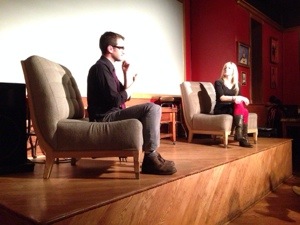I’m off to Brooklyn, Michigan to take a week long training on the NCIEX’s newly developed deaf interpreter curriculum for training new interpreters. link to the DI curriculum info. Should be an interesting week among peers from all over the country. Looking forward to it! (I am en route to the airport!)
ASL Slam interview was a success!
FCC adopts a new and stricter closed captioning Standards.
This is a great news for us Deaf and Hard of hearing population. This order focuses on 4 areas to ensure the quality of the closed captioning is high.
Quoted from the new order:
1) Accurate: Captions must match the spoken words in the dialogue and convey background noises and other sounds to the fullest extent possible.
2) Synchronous: Captions must coincide with their corresponding spoken words and sounds to the greatest extent possible and must be displayed on the screen at a speed that can be read by viewers.
3) Complete: Captions must run from the beginning to the end of the program to the fullest extent possible.
4) Properly placed: Captions should not block other important visual content on the screen, overlap one another, or run off the edge of the video screen.
Here is the link to the actual order: FCC order on closed captioning
Closed Captioning ruling update from FCC
I just wanted to share an announcement from FCC:
On January 12, 2012, the FCC adopted rules requiring captioned programs shown on TV to be captioned when they are re-shown on the Internet. These rules implement provisions of the Twenty-First Century Communications and Video Accessibility Act of 2010 (CVAA).
Starting March 30, 2013, when live and near-live programs are shown on TV with captions, these programs must be captioned when shown on the Internet. A “near-live” program is a program that is performed and recorded less than 24 hours before being shown on TV for the first time.
Prerecorded programs shown on TV with captions after September 30, 2012, have been required to be captioned when shown on the Internet since that date, if they were not substantially edited prior to being shown on the Internet.
Closed captioning requirements for other kinds of video programming – such as prerecorded programming that is substantially edited for Internet distribution – must be captioned at a later date.
Link to the news release:
http://hraunfoss.fcc.gov/edocs_public/attachmatch/DOC-319817A1.doc (Word)
http://hraunfoss.fcc.gov/edocs_public/attachmatch/DOC-319817A1.pdf (PDF)Link to information about filing complaints about accessibility for individuals with disabilities:
http://www.fcc.gov/complaints
Link to the FCC Consumer Guide: Captioning of Internet Video Programming:
http://www.fcc.gov/guides/captioning-internet-video-programming (HTML) http://transition.fcc.gov/cgb/consumerfacts/captionsinternet.pdf (PDF)
For more information, contact Eliot Greenwald at (202) 418-2235 or Eliot.Greenwald@fcc.gov, or Rosaline Crawford at (202) 418-2075 or Rosaline.Crawford@fcc.gov.
Great article on flexibility of Deaf Brain and Sign Language
It’s great to see more research are showing Sign Language in a more positive light, and hopefully that will have an impact in the future where Doctors and schools will recognize the value of a Deaf child being bilingual in Sign Language and English or whatever spoken language of the country, rather than suggest the child to only focus on the spoken language and not learn Sign Language. Its all about having a great foundation in at least 1 language at an early age, then learning 2nd or more languages becomes easier.
Deaf Interpreters in simultaneous and consecutive contexts
I am co-presenting with Eileen Forestal for NJRID, which will focus on interchanging between simultaneous and consecutive modes, with hands on practice and analysis. Hands on practice will include platform/conference interpreting. For more information, please check the link: workshop information
Great article on the impact of interpretation error
This article is a reminder for us interpreters to constantly monitor our interpretation, and ensuring that we work in teams, not solo. Just being bilingual is not enough, one must have full understanding of the translation process and how to analyze for meaning in both languages. Enjoy the link: 9 little translation mistakes that caused big problems
Exciting projects coming up this spring!
I’m honored to be an Emcee for the Northeastern University’s ASL Festival in March, and I will be co-presenting “Letting go of form: An experience with International Sign” along with Bill Moody. More details to come.
I also have been invited to be a presenter along with Byron Bridges for Aspen Camp’s ASL Boot Camp, in April!
I am currently teaching Advanced ASL II at LaGuardia Community College for 10 weeks. It’s going well and I enjoy working with the students who wanted to fine tune their ASL skills and analyze the language on a deeper level.
Stay Tuned!
Court and Legal Interpreting Coalition: Video Update
Court and Legal Interpreting Coalition had asked me to create an ASL version of their flyer. It has been finalized. Here it is:
[youtuber youtube=’http://www.youtube.com/watch?v=Jrxz30bbJn0′]
Working in Hawai’i
I look forward to starting the phase 2 of our work with local Hawaiian deaf interpreters in our follow up supervision training program. Additionally, I will be presenting and interpreting at the Region V conference in Waikiki.

